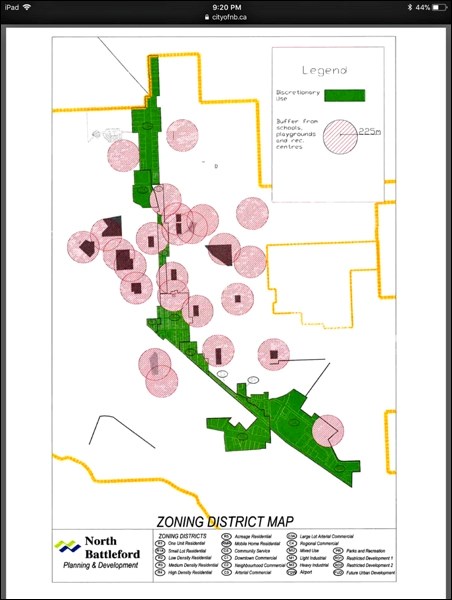A week after they were presented to Planning Committee, proposals for zoning amendments were introduced at city council Monday night. The proposed changes are being introduced in advance of the federal legalization of cannabis on July 1, as well as the pending allocation of two cannabis retail permits to the city by the SLGA.
There were not too many surprises at Monday night’s council meeting on the issue, as most of the changes had been covered at Planning Committee the week before.
The city gave direction to administration that would allow cannabis retail outlets as a discretionary use in the C1- Downtown Commercial, the C3 Arterial Commercial, the C3A Large Lot Arterial Commercial, and C4 Regional Commercial Districts.
But the biggest issue facing council on the evening was the distance to be set for the “buffer zones” that would prevent cannabis retail from setting up near schools, libraries, recreation facilities and public parks – in general, venues where youth might gather.
The previous week, administration had suggested 300 meters was the standard length of the buffer zones in most countries. For Monday’s meeting, however, some further information was provided that suggested more of a range.
Planner Anastasia Conly noted the proposed separation distances were as low as 150 m in the town of Battleford and the city of Victoria, and 160 m was being considered in Saskatoon.
But Conly noted these were the first communities out of the gate and it “might not necessarily be representative of the national trend,” she said.
Many American communities had buffers of 150 meters or more commonly, 300 meters, she noted.
In their latest report to council Monday, administration suggested 300 meters would be too restrictive and take up too many property options, and limit the number of potential retail locations.
But administration was also not comfortable with a buffer of 150 m, on the basis that it would not cover most of the sightlines near parks, schools and recreation areas.
Instead, administration recommended the middle ground: a 225-meter radius from those schools, libraries and other sensitive areas where youth would gather.
Councillor Greg Lightfoot, however, emphasized council “still had some options” available if they felt a cannabis retail location was not the right one, as cannabis retail was being allowed as a discretionary use.
“If we did find that we weren’t comfortable with the location being suggested, we could make that decision,” said Lightfoot.
The feeling is this would serve as an effective buffer from schools and libraries and so on, while providing enough room for cannabis outlets to set up elsewhere.
Ultimately, council gave direction to administration to prepare the bylaws, with separation distances at 225 meters included.
The other direction from the meeting was to allow cannabis cultivation, processing and manufacturing to be a permitted use in the heavy industrial districts.
Councillor Kelli Hawtin expressed support for cultivation as a permitted use in the industrial area, “given there’s going to be lots of federal regulations for those industry folks to follow in any case.” She also cited the need to be competitive with other communities.
Next up will be the actual preparation of the bylaws by city administration over the next few weeks. The bylaw will include both cannabis-related amendments and other changes as well.
The intention is to bring back the zoning bylaw amendments for first reading at their meeting April 23. The process will include a public hearing on May 28 and second and third reading happening June 11. A couple of public seminars are also planned.
The schedule “gives a lot of time for public engagement and public input,” noted Mayor Ryan Bater at council. He expressed confidence the bylaw changes would be in place in time for the July 1 legalization.
While direction to administration has been given, Bater emphasized there was still time for council to consider other options besides the 225-meter buffer, as the bylaw changes have not been passed.
“The decision’s not yet made. Council still has the discretion to choose a longer distance if it feels,” said Bater.
What will be key, the mayor indicated, is the public response to the zoning changes in the coming weeks.
“Now it’s a process of council and administration engaging with the public, getting the view of the people who live here, and coming up with an informed decision.”




